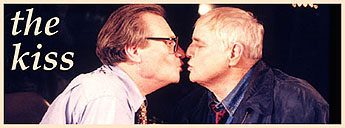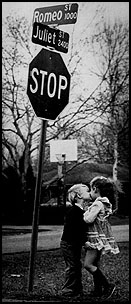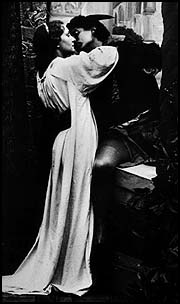
The Kiss
Has an attractive stranger ever approached you from across a crowded room and asked you if you'd like to...osculate? Well, perhaps not. But if such a thing ever were to happen, you shouldn't be alarmed; in fact, you would be living out one of the most romantic scenarios in all of the Western cultural traditions.
 Osculating, you see, is nothing more than kissing. And kissing is one of the most prevalent and complex interpersonal behaviors human cultures have to offer. It is a sign of affection, romance, love, eroticism, and even -- as the picture at right goes to show -- of sheer, unadulterated innocence. What follows is a brief examination of kissing: where it came from and what it has come to signify in modern U.S. culture.
Osculating, you see, is nothing more than kissing. And kissing is one of the most prevalent and complex interpersonal behaviors human cultures have to offer. It is a sign of affection, romance, love, eroticism, and even -- as the picture at right goes to show -- of sheer, unadulterated innocence. What follows is a brief examination of kissing: where it came from and what it has come to signify in modern U.S. culture.
The origins of osculation
Where did the idea of the "kiss" originate? One theory popular among anthropologists suggests that kissing is a derivative of a much older practice called "premastication"; premastication is when an adult, frequently a mother, chews food and then transfers the soft, premasticated food into the mouth of an infant or young child (Wickler 237). While most industrialized cultures have soft, enriched baby foods readily available, premastication was probably common in nearly all cultures through the ages (Wickler 241). It is easy to imagine how premastication could lead to what we know today as the maternal kiss between a mother and child.
Premastication also may have had a hand, in some cultures, in the development of the "romantic kiss." In the Ziller Valley of Central Europe, for example, the exchange of premasticated tobacco between a male and a female continues to be a popular romantic gesture.
The young man would let a tip of the piece of [tobacco] show between his closed teeth and invite the girl to grasp it with her teeth -- which of course obliged her to press her mouth firmly on that of the young man -- and pull it out. If a girl accepted the wad of premasticated tobacco, it meant she returned the boy's love. (Wickler 242)
While this specific practice cannot predate the introduction of tobacco in the 17th century, variations (using spruce resin or pitch) might have existed long before that time (Wickler 242).
Another popular theory about the origins of osculation is that kissing arose from various gestures symbolizing the fusion or union of souls. Nicholas Perella, author of The Kiss: Sacred and Profane, cites examples dating from as early as 2000 BCE, ranging geographically from India to Europe to Africa, wherein individuals would bring their faces together in gestures of spiritual union. For example, Indians believed that the exhaled breath was part of the soul; therefore, bringing one's mouth close to that of a fellow represented the intermingling of the souls. This is a clear antecedent of the "nose kiss," popularly attributed to the Eskimos. By bringing their faces together, two individuals exchange their breaths in a sort of spiritual union (Perella 4). A parallel to this concept in Christian dogma can be found in the "biblical narration (Gen 2:7) of the creation of man by a God who infused the spirit of life into his creature by breathing into him" (Perella 5).
Cultural meanings of the kiss
People who share a common culture also share a common lexicon by which they can interpret social behaviors. While different cultures ascribe different meanings to the same type of behavior (as you can attest to if, like most people in U.S. culture, the tobacco example above made you screw up your face in disgust), those from similar cultural backgrounds can expect to share similar notions of what certain behaviors mean.
For example, there are certain types of kissing in U.S. culture that most would agree upon and understand:
- Parent/child kissing: This is among the most common forms of kissing -- light, fast, and with pursed lips. This gesture is easily recognized as an act of love and affection. In U.S. culture, and in many other cultures, the symbolism changes dramatically if a parent/child kiss is too long or intense.
- Friends/family kissing (the social kiss): Miss Manners says that the social kiss is something "no two people perform alike" (Darling 110); Marjabelle Stewart points out that there is a huge variation in the amount of kissing which goes on between adult family members, from a whole lot to not very much at all (265). However, a quick kiss on the cheek or lips between family members is an easily recognized and interpretable cultural sign which conveys affection and love.
- The ceremonial kiss: It is particularly common in European countries (France, for example) for heads of state or other dignitaries to offer a ceremonial kiss upon meeting. This type of kiss, usually applied quickly to each side of the face, goes beyond social symbolism to a politcal symbolism -- it signifies goodwill on the part of both parties.
- The erotic kiss: The Romans were among the first to adopt and document this
 particular behavior (Pike 228), but doubtless its history goes back further still. The romantic/erotic kiss today is among the most widely practiced forms of intimate behavior in U.S. culture. More than 92 percent of U.S. teenagers have, like the lovers pictured to the right, engaged in romantic/erotic kissing (Coles 50).
particular behavior (Pike 228), but doubtless its history goes back further still. The romantic/erotic kiss today is among the most widely practiced forms of intimate behavior in U.S. culture. More than 92 percent of U.S. teenagers have, like the lovers pictured to the right, engaged in romantic/erotic kissing (Coles 50).
Paying some final lip service to the kiss
What is important here is that kissing -- like many learned behaviors -- is an important aspect of culture because of the significant meanings which are attached to it. It can be the most intimate gesture of love, as in the case of lovers, or the most culturally odious of crimes, as in the case of parent/child incest. It can be innocent or erotic, relaxing or intense. In any event, the many variations of kissing are behaviors which people from a common culture can easily interpret in similar ways.
View photo credits.
Return to the top of this page.
 return to the Learned Behaviors Page
return to the Learned Behaviors Page
 Osculating, you see, is nothing more than kissing. And kissing is one of the most prevalent and complex interpersonal behaviors human cultures have to offer. It is a sign of affection, romance, love, eroticism, and even -- as the picture at right goes to show -- of sheer, unadulterated innocence. What follows is a brief examination of kissing: where it came from and what it has come to signify in modern U.S. culture.
Osculating, you see, is nothing more than kissing. And kissing is one of the most prevalent and complex interpersonal behaviors human cultures have to offer. It is a sign of affection, romance, love, eroticism, and even -- as the picture at right goes to show -- of sheer, unadulterated innocence. What follows is a brief examination of kissing: where it came from and what it has come to signify in modern U.S. culture.
 particular behavior (Pike 228), but doubtless its history goes back further still. The romantic/erotic kiss today is among the most widely practiced forms of intimate behavior in U.S. culture. More than 92 percent of U.S. teenagers have, like the lovers pictured to the right, engaged in romantic/erotic kissing (Coles 50).
particular behavior (Pike 228), but doubtless its history goes back further still. The romantic/erotic kiss today is among the most widely practiced forms of intimate behavior in U.S. culture. More than 92 percent of U.S. teenagers have, like the lovers pictured to the right, engaged in romantic/erotic kissing (Coles 50).
 return to the Learned Behaviors Page
return to the Learned Behaviors Page